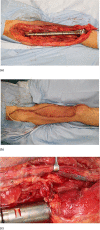Usefulness of perforating branches of the deep femoral artery and vein as recipient vessels during free-flap reconstruction for extensive defects of the thigh
- PMID: 38163057
- PMCID: PMC10755091
- DOI: 10.1093/jscr/rjad683
Usefulness of perforating branches of the deep femoral artery and vein as recipient vessels during free-flap reconstruction for extensive defects of the thigh
Abstract
The perforating branches of the deep femoral artery and vein are considered useful recipient vessels during free-flap reconstruction for extensive defects extending from the knee to the mid-thigh or from the lateral to the posterior region of the thigh. Despite being located deep between the adductor longus and magnus muscles, they can be easily identified, allowing for a sufficient surgical field for the vascular anastomosis. Approximately four perforators from the deep femoral artery can be found on the posterior aspect of the thigh, easily identified by dissecting the semitendinosus and biceps femoris muscles. The calibre and length of the perforators were suitable for vascular anastomosis. In this study, we present three cases of free-flap reconstruction for extensive thigh defects using perforating branches of the deep femoral artery and vein as recipient vessels.
Keywords: deep femoral artery; deep femoral vein; perforator; recipient vessel; reconstruction; thigh.
Published by Oxford University Press and JSCR Publishing Ltd. © The Author(s) 2023.
Conflict of interest statement
None declared.
Figures



Similar articles
-
[Anatomical classification and application of chimeric myocutaneous medial thigh perforator flap in head and neck reconstruction].Zhonghua Er Bi Yan Hou Tou Jing Wai Ke Za Zhi. 2020 May 7;55(5):483-489. doi: 10.3760/cma.j.cn115330-20190711-00436. Zhonghua Er Bi Yan Hou Tou Jing Wai Ke Za Zhi. 2020. PMID: 32842363 Chinese.
-
Breast reconstruction using free medial circumflex femoral artery perforator flaps: intraoperative anatomic study and clinical results [corrected].Breast Cancer. 2017 May;24(3):458-464. doi: 10.1007/s12282-016-0728-x. Epub 2016 Sep 13. Breast Cancer. 2017. PMID: 27624602
-
Breast reconstruction using free posterior medial thigh perforator flaps: intraoperative anatomical study and clinical results.Plast Reconstr Surg. 2014 Nov;134(5):880-891. doi: 10.1097/PRS.0000000000000587. Plast Reconstr Surg. 2014. PMID: 25347624
-
Perforating arteries of the anteromedial aspect of the thigh: an anatomical study regarding anteromedial thigh flap.Surg Radiol Anat. 2011 Apr;33(3):241-7. doi: 10.1007/s00276-010-0738-x. Epub 2010 Oct 26. Surg Radiol Anat. 2011. PMID: 20976454
-
Internal mammary artery perforators as recipient vessels for free tissue transfer in head and neck reconstruction: A case report and literature review.Microsurgery. 2021 May;41(4):355-360. doi: 10.1002/micr.30680. Epub 2020 Nov 7. Microsurgery. 2021. PMID: 33159486 Review.
References
-
- Chia HL, Wong CH, Tan BK, et al. An algorithm for recipient vessel selection in microsurgical head and neck reconstruction. J Reconstr Microsurg 2011;27:47–56. - PubMed
-
- Kim JH, Kwon HJ, Moon SH, et al. Trochanteric area reconstruction with free flap using perforators as recipients: an alternative and effective option. Microsurgery 2020;40:32–7. - PubMed
-
- Power HA, Cho J, Kwon JG, et al. Are perforators reliable as recipient arteries in lower extremity reconstruction? Analysis of 423 free perforator flaps. Plast Reconstr Surg 2022;149:750–60. - PubMed
Publication types
LinkOut - more resources
Full Text Sources

